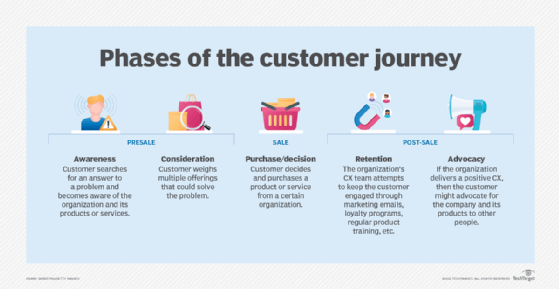
Customer success vs. sales: What's the difference?
Customer success and sales teams both interact with clients, but customer success prevents churn, whereas sales teams focus on acquisition.
While sales teams bring in new customers, customer success teams increase retention.
Organizations need sales teams to find leads and convert them into new customers. However, customer retention is a more cost-effective way to generate revenue than new customer acquisition. As a result, many organizations staff customer success teams to build relationships with existing customers and reduce churn. Customer success and sales can work together to ensure positive CX, but they have different goals, responsibilities, skills, earning potential and metrics.
To efficiently manage the customer journey, CX leaders should know the difference between customer success and sales.
What is customer success?
Customer success is a business strategy B2B organizations use to build strong relationships with existing customers and increase customer retention.
Customer success teams work closely with customers to understand their pain points and help them achieve long-term business goals. These teams serve as a point of contact for customers in the postsale phases and help with product onboarding, training and troubleshooting.
What is sales?
Sales describes any activity organizations use to turn leads into customers. Most organizations have a team of sales representatives who identify new leads, build rapport with them and close deals.
These reps serve as a point of contact with customers during the consideration and purchase phases of the customer journey and usually receive a commission in addition to a base salary.
5 differences between customer success and sales
Customer success managers and sales reps each have customer-facing roles, but they have important differences.
1. Goals
The goal of customer success is to improve customer retention and satisfaction. Customer success teams can improve retention by working closely with customers to ensure that products and services meet their needs.
For example, customer success managers for a SaaS vendor might host virtual presentations or in-person training sessions to help onboard customers. Additionally, they can regularly check in with and collect feedback from customers to see if they need additional training or want to adjust their configuration settings.
The goal of sales, on the other hand, is to convert leads into customers. For example, sales reps must first identify and build rapport with leads. Then, the reps share how their product can fix the leads' pain points. Finally, they negotiate prices and close deals. Unlike customer success teams, which work with their customers indefinitely, a sales rep's relationship with a customer typically ends after the customer makes a purchase.

2. Responsibilities
Customer success managers and sales reps have different responsibilities.
Common responsibilities of a customer success manager include the following:
- Manage customer onboarding and training.
- Maintain long-term customer relationships.
- Frequently collect feedback.
- Identify upselling and cross-selling opportunities.
- Inform development teams of common product pain points.
- Answer questions and offer technical support.
A sales rep's responsibilities, on the other hand, include the following:
- Use sales software to find new leads.
- Make calls and send emails to leads.
- Create presentations.
- Schedule meetings with leads.
- Track relationships in a CRM system.
- Meet sales quotas.
After sales teams close a deal, they hand clients off to customer success teams. Communication between these teams ensures clients have a positive experience across the whole customer journey.
3. Skills
Customer success and sales skills overlap in some areas and diverge in others. For example, customer success managers and sales reps both require friendliness to build relationships with customers. Friendliness helps sales reps quickly build rapport with leads, while it helps customer success managers maintain long-term relationships with existing customers.
Customer success and sales teams also need customer service skills, such as empathy, so they can effectively assist frustrated or wary customers. For instance, customer success teams might need to solve technical issues for disgruntled customers, whereas sales reps might need to win over skeptical or unfriendly leads.
However, customer success managers generally need more product knowledge than sales reps. Sales reps need basic product knowledge to explain how products can solve customers' problems, but customer success teams train users on the products, configure them for various use cases and troubleshoot issues as they arise.
Sales reps, on the other hand, require a greater ability to persuade people than customer success managers. For example, sales reps use tactics like storytelling or creating a sense of urgency to persuade leads to make a purchase. Customer success teams avoid these tactics because they can erode customer trust over time.
4. Earning potential
Sales roles have a high earning potential because reps often receive a commission payment for each deal they close in addition to a base salary. However, this payment structure can lead to income instability and stress for reps.
Conversely, most customer success professionals receive a fixed salary with little or no commission-based compensation. People who value stability over high earning potential typically prefer customer success roles.
5. Metrics
To evaluate the effectiveness of a customer success strategy, organizations should use metrics that gauge customer satisfaction, loyalty and retention. Sales metrics focus more on revenue.
Common metrics to track customer success efforts include the following:
- Customer satisfaction score. A CSAT score measures the degree to which customers feel satisfied with an organization's products or services. CSAT surveys ask customers to rate their experiences on a scale from one to five or one to 10.
- Net Promoter Score. An NPS can help organizations measure customer loyalty. NPS surveys ask customers to rate how likely they are to recommend a company, product or service to family and friends.
- Churn rate. Churn rate measures the number of customers that leave an organization over a specific period. To calculate churn rate, organizations divide the number of churned customers by the total number of customers at the start of the period.
Metrics to gauge sales performance include the following:
- Total revenue. Total revenue measures how much money an organization generates before expenses over a given period. Organizations often use this metric to compare one year's revenue to the previous year, which lets them identify growth trends.
- Revenue by product. Organizations can also measure how much revenue specific products or services generate over a period. This measurement helps organizations decide which products and services to prioritize, improve or discontinue.
- Lead conversion rate. Lead conversion rate measures the percentage of leads that eventually make a purchase. This metric helps sales reps predict how many sales they will make based on how many leads they have in their sales pipeline.
How do customer success and sales work together?
In a broad sense, customer success and sales teams work together to help organizations grow. Growth requires organizations to acquire customers at a faster rate than they churn. As sales teams handle the acquisition, customer success teams improve loyalty and minimize churn.
These teams also communicate with each other to ensure customers have a smooth transition from the purchase phase to the postsale phase of the customer journey. For example, after sales reps close a deal, they brief the customer success team on the client's pain points and business goals. This information, which sales reps can collect throughout the sales process, helps customer success teams offer more effective service early on.
Additionally, as customer success teams work closely with customers over long periods, they alert the sales department of upselling and cross-selling opportunities. Sales teams can then engage customers in negotiations and close more deals.
Tim Murphy is site editor for Informa TechTarget's SearchCustomerExperience and SearchContentManagement sites.






